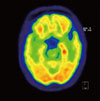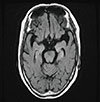Abstract
Encephalitis that primarily involves limbic system structures such as the hippocampus and parahippocampal gyrus has been described in early papers, most commonly characterized by a subacute progressive impairment of short-term memory, psychiatric features and seizures. While these findings might be caused by viral infections or systemic autoimmune disorders, many patients with limbic encephalitis have an immune-mediated etiology (paraneoplastic or not) characterized with serum or CSF antineuronal antibodies. This case reports about non-paraneoplastic autoantibody-negative limbic encephalitis in which there are no detection of antigens and no evidence of tumors.
Figures and Tables
Fig. 1
Axial brain MR T2-weighted image (T2WI) and fluid-attenuated inversion recovery (FLAIR) image show increased signal intensity in both medial temporal lobe (A, C). T1-weighted image (T1WI), Gadolium (Gd)-eahauced T1-weighted MRI and DWI study shows no hyperintensity on bilateral temporal lobes with isointensities on ADC map (B, D, E, F).

References
1. Brierley JB, Corsellis JAN, Hierons R, Nevin S. Subacute encephalitis of alter adult life, mainly affecting the limbic areas. Brain. 1960; 83:357–368.

2. Kondziella D. Case report on non-paraneoplastic autoantibody-negative limbic encephalitis. http://www.neuropenews.org/?p=65.
3. Won Y, Kim JY, Park HJ. A case of voltage gated potassium channel antibodies-associated nonparaneoplastic limbic encephalitis. J Korean Neurol Assoc. 2006; 24:148–152.
4. Vincent A, Bien CG, Irani SR, Waters P. Autoantibodies associated with diseases of the CNS: new developments and future challenges. Lancet Neurol. 2011; 10:759–772.

5. Kim MH, Oh SH, Shin DK. Limbic encephalitis caused by human herpesvirus-6 infection in allogenic hematopoietic stem cell transplantation patient. J Korean Neurol Assoc. 2010; 28:132–134.
6. Cho TY, Kim YJ, Lee BI. A case of limbic encephalitis associated with small cell lung? cancer-about diagnostic MRI Findings. J Korean Neurol Assoc. 1994; 12:338–342.
7. Cho HJ, Jo JW, Park KP. A case of paraneoplastic limbic encephalitis associated with immature ovarian teratoma. J Korean Neurol Assoc. 2003; 21:647–650.
8. Han SH, Chi HS. A case of paraneoplastic limbic encephalitis presenting anti-purkinje cell antibody. J Korean Neurol Assoc. 2005; 23:724–726.
9. Gultekin SH, Rosenfeld MR, Voltz R, Eichen J, Posner JB, Dalmau J. Paraneoplastic limbic encephalitis: neurological symptoms, immunologic findings and tumor association in 50 patients. Brain. 2000; 123:1481–1494.

10. Kim KK. Paraneoplastic syndrome. J Korean Neurol Assoc. 2002; 20:215–222.
11. Lancaster E, Martinez-Hernandez E, Dalmau J. Encephalitis and antibodies to synaptic and neuronal cell surface proteins. Neurology. 2011; 77:179–189.

12. TUZUN Erdem. Limbic Encephalitis Associated with Antibodies to Cell Membrane Antigens. Arch Neuropsychiatry. 2007; 44:101–107.




 PDF
PDF ePub
ePub Citation
Citation Print
Print





 XML Download
XML Download